-
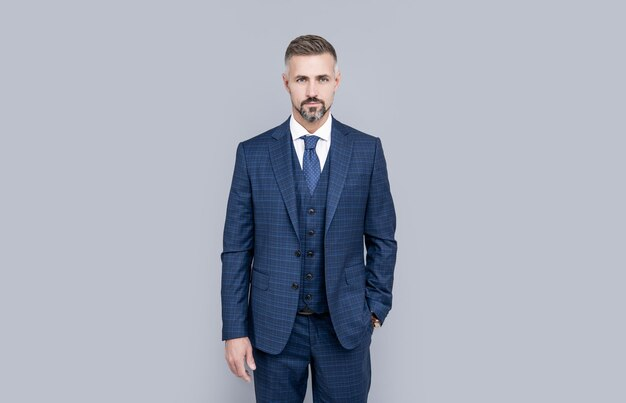 What is a Power Suit?
What is a Power Suit?A power suit is something more than just a stylish outfit; it is a sign of confidence, authority, and professionalism. Often associated with the business world, power suits are designed to make a statement in the office, at a meeting, or at any high-stakes event. They are a must-have for those who want to show confidence and leadership, especially in a business or formal setting.
In this article, we explore what a power suit is, when and how to wear one, and how to find the perfect power suit for both men and women. We also look at color choices, ways of customization, and accessories that can help make your power suit pop.
The Characteristics of a Power Suit
Classic vs. Modern Power Suits
A classic power suit is defined by its sharp lines, structured fit, and timeless colors. Typically, these suits are dark colors, such as black, navy, or charcoal gray, paired with a solid tie and simple accessories. Classic power suits have stood the test of time because they exude authority and sophistication.
On the other hand, modern power suits tend to incorporate contemporary design elements, such as slimmer cuts, lighter fabrics, and an expanded color palette. Suits allow individuals to show their personal taste while still being professional. Whether it's classic or modern, whether it fits and enhances you is the bottom line.
Core Features of a Power Suit
Regardless of style, there are a few features that define a power suit. First and foremost, the fit-the most stylish suit in the world will not have the same effect if it does not fit. A tailored fit is absolutely essential to creating that sharp, defined silhouette that is synonymous with the power suit.
Other key features include:
· Quality fabric: Often, wool, tweed, and high-end cotton blends are used to make power suits because they are both durable and elegant.
· Structured shoulders: This feature adds to the commanding presence of the suit.
· Clean lines: A power suit should have a crisp, unbroken look without too much embellishment or distraction.
· Sharp tailoring: A suit fitted to your body shape will make you look not only professional but also more comfortable.

When to Wear a Power Suit?
Ideal Situations for Wearing a Power Suit
Power suits are typically reserved for occasions that require a high level of professionalism and authority. Some of the ideal situations include:
· Job interviews: A power suit gives off a strong impression and conveys your seriousness about the position.
· Business meetings: Whether you’re pitching a new project or negotiating terms, a well-tailored power suit helps establish credibility.
· Formal events: In business-related formal events, such as galas or conferences, a power suit signals your commitment to success.
Impact of a Power Suit in Career Development
A power suit can play a significant role in career advancement. Wearing a suit that makes you feel powerful boosts your confidence, which in turn affects how others perceive you. People are more likely to respect you and listen to your judgment when you present yourself with authority. Many times, a power suit translates visually that you're able, capable, and up for any challenge, and thus it is one of those wardrobe investments one should make if one wants to rise the corporate ladder.
Power Suits for Women: What is a Female Power Suit?
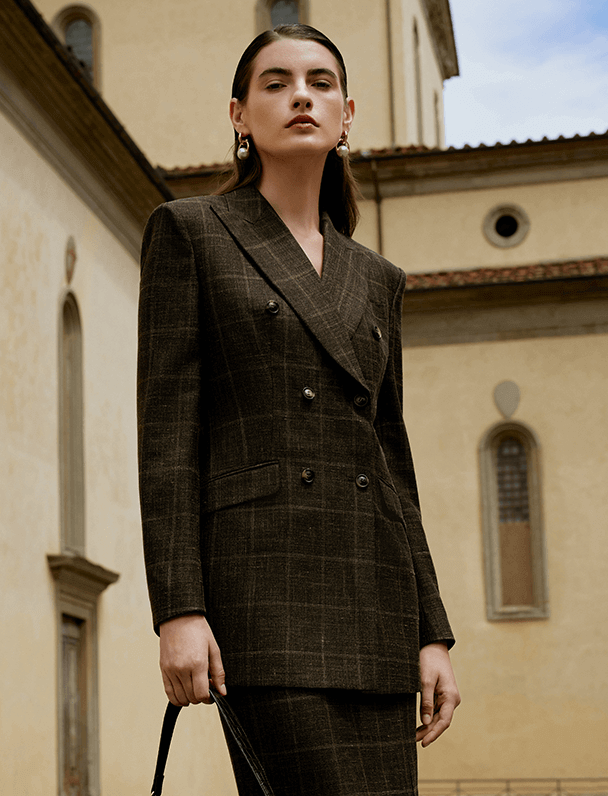
Key Elements of a Women's Power Suit
While similar to the male power suits in many ways, there is a subtle difference that makes them very feminine. The fits are tailored to accentuate the female form in a professional manner. The blazers can be slightly fitted; the trousers or skirts softer and more streamlined.
The fabric choices for women's power suits include sumptuous wool blends, cotton, and, on occasion, silk to give it that touch of refinement. The aim is to project both professionalism and femininity without compromising on authority.
If you are a woman seeking a more tailored, unique style, consider working with custom woman's wear to create a suit that fits your exact preferences. Additionally, choosing custom formal wear ensures you have a suit that meets professional standards while also reflecting your personal taste.
Differences Between Men's and Women's Power Suits
The major difference between power suits for men and those for women lies in the fit and structure. Men's suits have a more rigid structure, while for women, it may be different with regard to tailoring around the waist and hips. The women's power suits may include skirts, dresses, or pants, thereby allowing more styling options.
Besides, women's power suits are often designed to combine authority with elegance. For example, soft details like feminine lapels, button placements, or waistbands are used to enhance the suit's visual appeal without losing the professional edge.
For those interested in more bespoke, personalized options, made-to-measure suits online offer the flexibility of ordering a suit that perfectly fits your measurements and style preferences, ensuring that you always look your best.
What Color is a Power Suit?
Best Colors for Men's Power Suits
The color of your power suit plays a significant role in how other people perceive you. Classic dark colors such as black, navy, and charcoal gray are considered to be the best options for men. These colors are associated with formality and professionalism; hence, they are ideal for major business meetings and interviews.
Best Colors for Women's Power Suits
For women, black, navy, and charcoal are also the popular choices, but modern designs have included a broader palette such as deep burgundy, dark green, or even rich purple. These colors can keep the sense of professionalism while adding your identity to your look.
Color Combinations and Contrast in Power Suits
In both men's and women's power suits, the jacket and trousers/skirt combination can often make or break the look. A classic monochrome suit-color for both pieces-allows for streamlined power, while subtle contrast (think dark blazer with lighter-colored trousers) can add much depth and interest to your outfit. Accessorize with ties, pocket squares, and jewelry for contrast and personality without overkill.
How to Pick the Perfect Power Suit
Tailoring and Fit
The key to finding a perfect power suit is the fit. Even the most costly suit will not look good if it does not fit. When trying on a suit, the shoulders and chest should be fitted yet comfortable. Trousers should be hemmed to the right length, while the jacket should hit at the right point on your hips.
Fabrics to Look For
For quality, look to wool for durability and breathability, cotton blends, or tweed for a fantastic power suit. These types of fabrics will give you that nice, polished look and will also help to keep you comfortable during your day. The fabric must also be seasonal-lighter fabrics such as linen and cotton for summer and heavier wool during the colder months.
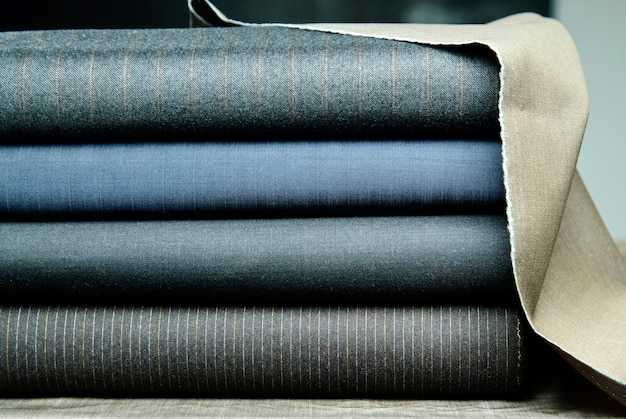
Accessories and Final Touches
Essential Accessories
Accessories are the finishing touches to any power suit. Ties, cufflinks, watches, and pocket squares are classic options that really bring out the look in your suit. Women may add scarves, brooches, or statement jewelry to complete their power suit ensemble.
Common Mistakes to Avoid
When it comes to power suits, it is very easy to over-accessorize or go overboard with too much detail. Avoid:
· Over-accessorizing: Keep it simple and classic.
· Poor fit: Your suit should fit well and not bunch or sag.
· Cheap fabrics: A cheaply made suit will undermine your authority.
How to Custom the Perfect Power Suit
The Benefits of Customization
A custom power suit is the best way to ensure that every detail fits perfectly to your body shape. Custom suits allow you to choose the fabric, color, and style that best suit your personality and professional needs.
Steps to Customize Your Power Suit
1. Selecting fabric: Choose a multitude of available fabrics for your various requirements.
2. Take accurate measurements: Take help from expert tailors for best measurement results.
3. Select Detail Options: Choosing options on lapels, buttons, and other features offering scope for customization.
4. Try it on: Fit alteration adjustments needed to be perfect.
Common Questions
1. What is the difference between a power suit and a regular suit?
A power suit is specifically designed to show confidence, authority, and professionalism. It may also have a more tailored cut and better quality of fabric than the usual suit.
2. How do I choose the right fabric for a power suit?
Go for fabrics that are strong, breathable, and right for the season: wool for cold and cotton blends for hot countries.
3. Is it worth investing in a custom power suit?
Yes, a tailored power suit will fit perfectly, ensuring comfort and looking great while making a great professional impression.
4. Can women wear power suits?
Yes. The women's power suit has evolved to incorporate style with authority, offering tailored options that exude confidence while remaining feminine.
5. How should a power suit fit for a job interview?
Your power suit for a job interview should fit perfectly: snug at the shoulders, trousers or skirt hemmed to the right length; it should look professional and convey confidence without being too tight or too loose.
MORE 2024-12-17 -
 British vs. American vs. Italian Suits: Which is Right for You?
British vs. American vs. Italian Suits: Which is Right for You?Suits have long been a symbol of sophistication and professionalism, but not all suits are created equal. Whether you’re preparing for a job interview, attending a formal event, or simply adding a new suit to your wardrobe, the fit, style, and overall aesthetic of the suit matter. Suits are made in many different ways, but among the most well-known are the British, American, and Italian suits. Each of these different suit styles has its own distinct features, designed for various tastes and body types.
In this article, we will look into the major differences between the British, American, and Italian suit styles. We are going to take a closer look at history, features, and best occasions of each suit type that would help you decide which is best for you.
British Suit
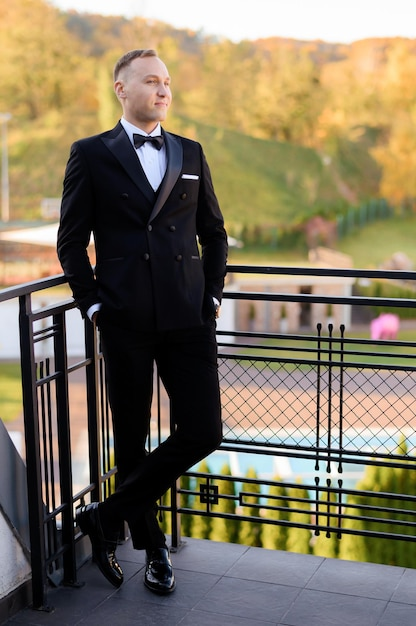
The Traditional British Tailoring
British suits are classic, elegant, and refined in their tailoring. With a long history of craftsmanship and tradition, British suits have become synonymous with sophistication. They are typically crafted with attention to detail, emphasizing structure and formality. British tailoring is characterized by precision and sharp lines, thus making it ideal for formal and professional occasions.
Historical Influence of British Suits
British suits trace their origin from the early 19th century and more precisely to the age of the British aristocracy. The traditional British suit thus evolved from the class that had been royal and upper, where formality in everyday life was a reality. In due course, these turned into the more structured, sharper-cut styles we know today-the quintessential Savile Row suit that set the mark for British tailoring.
Key Features of British Suits
· Structured Shoulders: British suits mostly have natural, structured shoulders that make the man in a suit look more formal and powerful.
· Tighter Fit: The British suit is close-fitting and accentuated at the waist, to get slim smart cuts.
· Double-Breasted Jackets: The double-breasted jacket gives them a classic touch for making British suits formal.
· Tweed and Wool Fabrics: Most of the British suits are made from heavy fabrics such as tweed or wool. Both are durable and warm.
Best Occasions for Wearing a British Suit
British suits are ideal for formal events and office wear. Whether it is a business meeting, a wedding, or a significant conference, a British suit will make you stand apart with its commanding presence. They are best suited for colder climates, hence being more in demand during fall and winter seasons.
American Suit
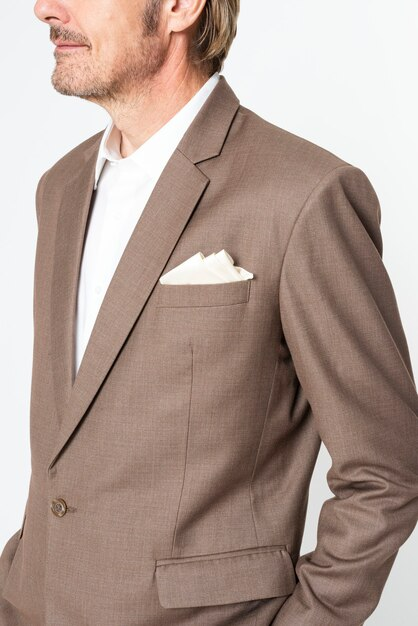
The American "Sack Suit"
The American suit is sometimes called the "sack suit," more comfortable and less formfitting compared with its European cousins. The sack suit found popularity in the U.S. in the latter half of the 19th century, serving as a reply to the much more formal and rigid British tailoring. The American style, which focuses on comfort and practicality, made it suitable for everyday wear.
History Behind American Suits
American suits were influenced by the industrial revolution and the rise of mass production. The sack suit was created to accommodate the growing American middle class, which prioritized comfort and ease of movement over formality. As the style gained popularity, it became a symbol of American practicality and style.
Key Features of American Suits
· Loose Fit: The American suit is not slim in cut, unlike the British suit; it is looser and more relaxed to provide comfort.
· Soft Shoulders: The shoulders are softer and less structured than those of British suits, giving them a more relaxed appearance.
· Single-Breasted Jackets: American suits are often made with single-breasted jackets, adding to the suit's casual and flexible nature.
· Lighter Fabrics: American suits are mostly made from lighter fabrics like cotton, linen, and lightweight wool. Thus, these are suitable for the warmer climates.
Best Occasions for Wearing an American Suit
American suits are versatile and work just fine for casual and semi-formal events, respectively. They are perfect for office wear, casual weddings, and social events where comfort is what one needs. For a more relaxed yet polished look, you can easily pair them with custom Smart Casual outfits. Additionally, if you're looking for a tailored approach to custom formal wear for business settings, American suits can be dressed up with a tie for more formal events or worn casually without a tie.
Italian Suit
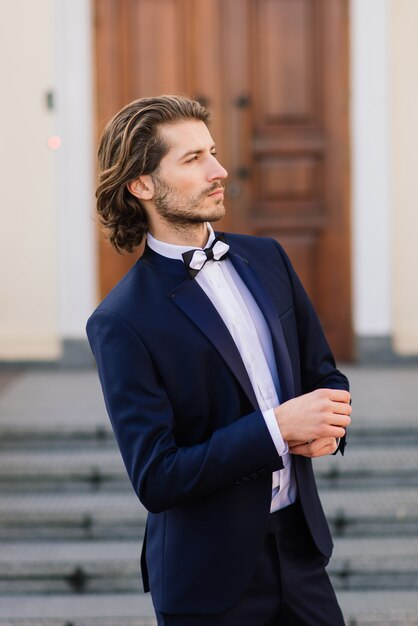
Italian Suit Characteristics
Italian suits are sleek, stylish, and luxurious in design. They are often considered the epitome of fashion, with a focus on cutting-edge styles and high-end materials. Italian tailoring focuses on a sharp, slim silhouette and is designed to flatter the wearer's physique. The key to an Italian suit is its bold and confident style that commands attention.
The Influence of Italian Fashion on Modern Suits
Italy, more so Milan, is considered one of the fashion capitals of the world. Italian suit styles boast a rich heritage in the fashion world by incorporating traditional custom apparel manufacturers techniques alongside modern innovations. This ensures that each suit is a blend of contemporary fashion and old-world craftsmanship.
Best Occasions for Wearing an Italian Suit
Italian suits are best for formal events, fashion-forward occasions, and high-profile gatherings. Whether it's a red carpet event, an important gala, or a high-class business dinner, an Italian suit will definitely make a bold statement in fashion. Italian suits are also suitable for men who want to stand out with their unique sense of style while maintaining a high level of sophistication.
Which Suit Style is Best for You?
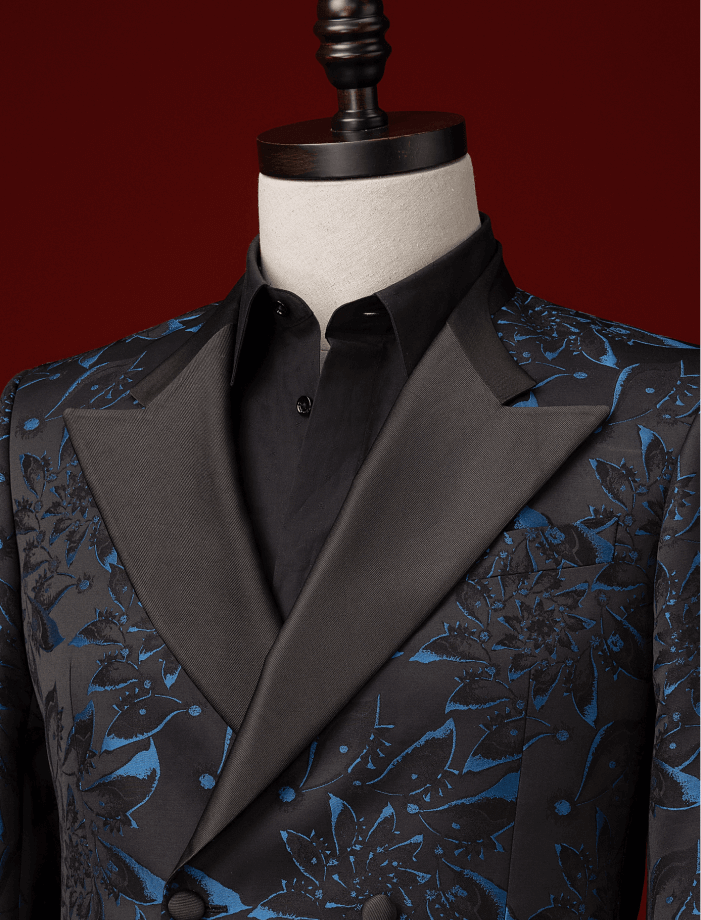
For a Tall, Slim Build: Italian Suits
If you are tall and slim, then an Italian suit will be a great choice. The slim, tailored cut of the Italian suit will highlight your frame and give you a sharp, sleek silhouette. The Italian style is made to make the most of a tall, lean physique, adding a touch of modernity to your wardrobe.
For a Stocky, Broad Build: British Suits
If you have a broader or stockier build, then the British suit is your best option. The structured shoulders and tailored fit of the British suit help create a more balanced and refined look. The classic lines of the British suit will give you a powerful, commanding appearance, making it great for formal settings and professional environments.
For Comfort and Flexibility: American Suits
If you want your fit to be relaxed, that is comfortable, the American suit is the one for you. The loose cut, roomy, and soft shoulders of this American suit provide flexibility and comfort for wearing on casual or semi-formal occasions. It is highly suitable for those individuals who want comfort but not at the cost of fashion.
Conclusion
Ultimately, the choice between a British, American, or Italian suit will come down to personal preference, body type, and the nature of the occasion. A British suit is sharp and formal with structured tailoring; it's ideal for colder climates and professional settings. The American suit is comfortable and relaxed; it's good to go for casual or semi-formal occasions. Whereas, for someone looking to make a bold and stylish statement in very high-profile events, an Italian suit will be the one.
FAQs
1. What is the difference between Italian and British suits?
Italian suits are slim in cut, whereas the British ones have structured fits and are more formal in nature with classic, fitted cut.
2. What are the characteristics of a British suit?
British suits are characterized by structured shoulders, a tight fit, and often come in heavy fabrics such as wool and tweed. They are ideal for formal occasions.
3. Which kind of suit is best for a formal event?
A British suit is the best choice for formal events because it gives an air of professionalism and authority with its sharp lines and structured fit.
4. What are the main differences between American and Italian suits?
American suits are looser and more relaxed, emphasizing comfort. Italian suits are slim-cut and stylish, focusing on high-fashion aesthetics.
5. Can women wear British or Italian suits?
Yes, women can absolutely wear both British and Italian suits. Women's suits in these styles are tailored to fit the female form while maintaining the style and sophistication of the traditional suit.
MORE 2024-12-17 -
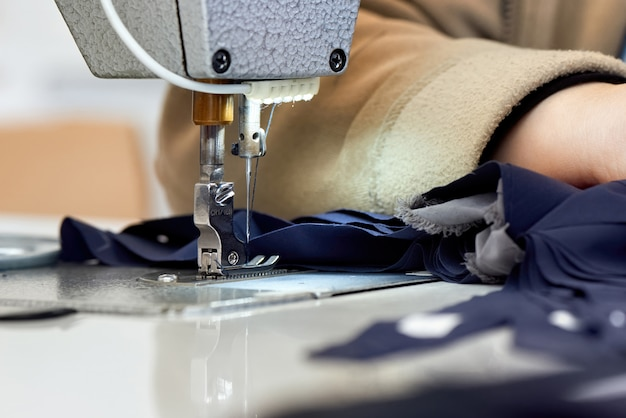 Top 10 Clothing Manufacturing Countries in the World
Top 10 Clothing Manufacturing Countries in the WorldThe garment manufacturing industry is quite vast, with different countries contributing to the production meant for meeting the needs of brands worldwide. Whether you are a fashion startup or a large multinational brand, choosing the right manufacturing country is critical to achieving cost-effectiveness, high quality, and timely delivery. In this article, we go into an overview of the top clothing manufacturing countries in the world, as well as the things to consider when selecting a manufacturing partner for your brand.
Top Clothing Manufacturing Countries in the World
1. China
China is still the biggest player and most influential in the clothing manufacturing industry. It produces the maximum number of garments globally. Its manufacturing capacity is unmatchable on a larger scale.
Key strengths of China’s clothing manufacturing industry:
· Scale and volume: China is able to manufacture both at small and high volumes of garments, making it ideal for fast fashion and bulk orders.
· Advanced Technology: It's leading in countries with automation, textile machinery, and smart manufacturing features that ensure efficiency and consistency.
· Cost-effectiveness: Production costs are competitive in China while the quality remains high, hence it is a main contracting state for brands around the world.
· Field experience: From luxury clothing to everyday wear, garment factories of China cover almost all types of products. This makes China a great destination for custom clothing manufacturers looking to scale their operations.
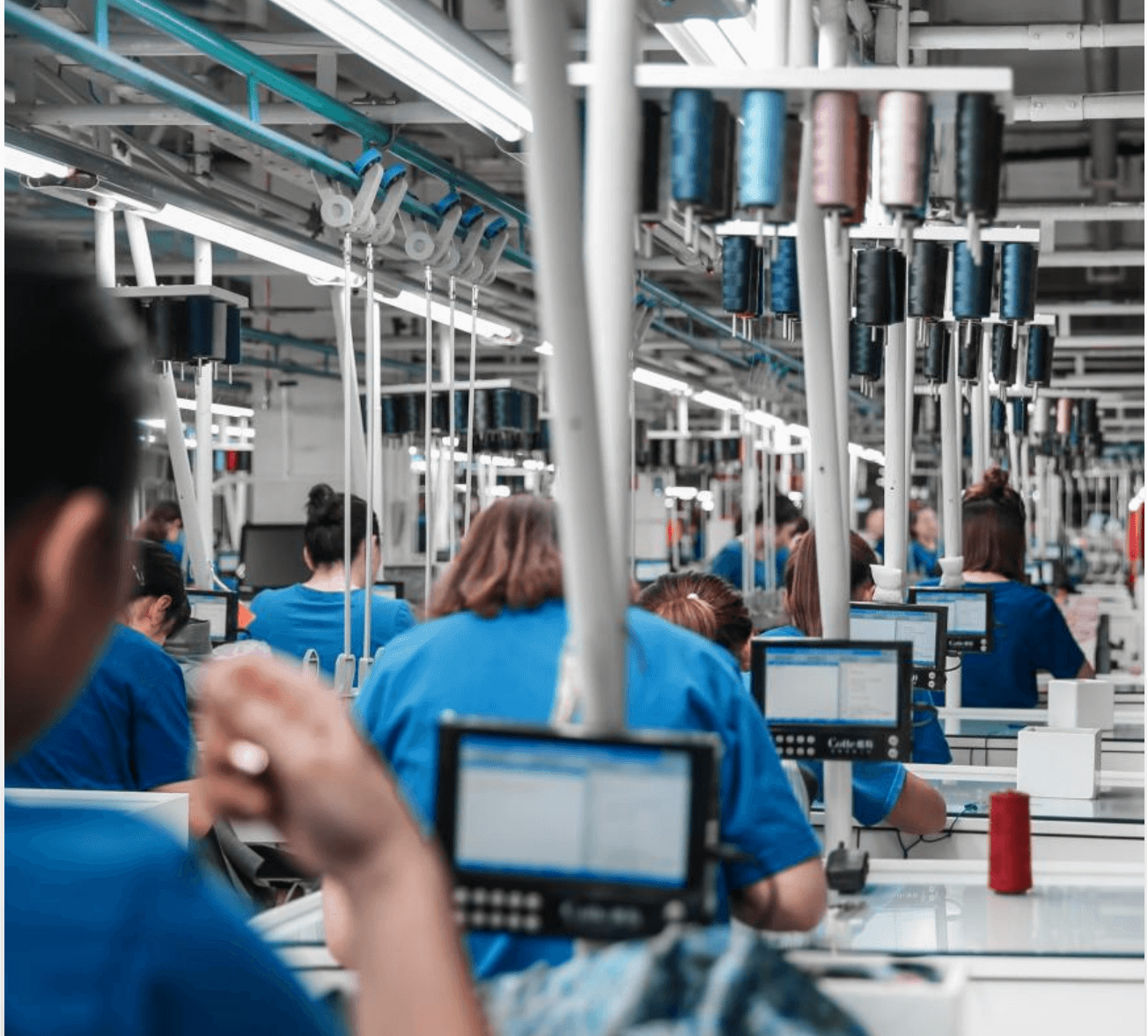
2. Bangladesh
Bangladesh has gained tremendous momentum as one of the most cost-effective clothing manufacturing bases in the world. Low labor costs and a huge young workforce make Bangladesh quite ideal for brands seeking low-cost garment production. During the last few years, Bangladesh has emerged as one of the major exporters of clothes, especially in the fast-fashion segment.
Key strengths of Bangladesh’s clothing manufacturing industry:
· Low labor costs: One of the most inexpensive countries for garment productions, hence suitable for bulk orders in the fast fashion industry.
· Large workforce: It has a considerable amount of highly skilled and young labor that is experienced in garment manufacturing.
· Growth potential: Bangladesh's apparel export is growing day by day. Big global brands are attracted to this due to its affordable, superior quality production.
3. Vietnam
Vietnam is rapidly emerging as a strong competitor in garment manufacturing worldwide. It is turning out to be one of the favorite destinations, as its low labor cost has become combined with rising quality standards.
Key strengths of Vietnam’s clothing manufacturing industry:
· Skilled labor: It has an increasingly skilled workforce in Vietnam that is rapidly improving its high-end garment production capabilities.
· Competitive costs: Labor costs are generally low, which makes it a popular destination for global brands.
· Sustainability focus: Most Vietnamese manufacturers opt for eco-friendly production methods, making them particularly attractive to brands with sustainable development agendas.
4. India
India has a great historical background in textile production and remains one of the world's major textile producers. Being acknowledged as one of the finest cotton producers and qualitative fabrics, India skillfully combines traditional craftsmen and state-of-the-art manufacturing technologies to be amongst the top destinations for all possible ranges of apparel products.
Key strengths of India’s clothing manufacturing industry:
· Rich textile heritage: The textile industry in India is deeply rooted in traditional techniques and craftsmanship that add to the quality in garments.
· Large cotton production: India is the second-largest producer of cotton, which fuels its garment manufacturing industry.
· Competitive pricing: India offers competitive production costs without compromising on the quality standards, making it a strong contender in the global market.
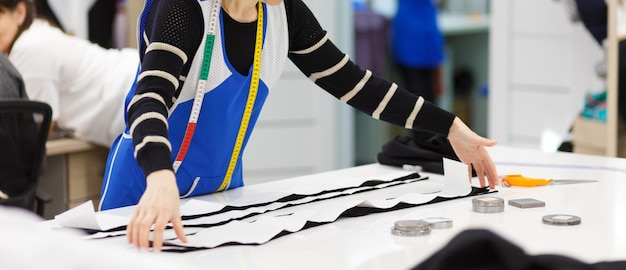
5. Italy
Italy is synonymous with luxury fashion and high-quality garment manufacturing. While it is not as large as China or Bangladesh in volume, Italy nevertheless remains a leader in producing high-end clothing and fabrics. Italian manufacturers put much emphasis on quality, design, and craftsmanship, making the country one of the top destinations for luxury apparel brands.
Key strengths of Italy’s clothing manufacturing industry:
· Luxury focus: Italian industries create high-fashion garments as well as luxury fabrics, thus being a desired destination for premium brands.
· Innovative design: Italian manufacturers are known for modern design, innovative textiles, and craftsmanship; they thus set trends in the global fashion industry.
· Sustainability: Many manufacturers in Italy stress eco-friendly practices, thus being a sustainable option for the manufacturing of luxury fashion brands.
6. Turkey
During the last two decades, Turkey has emerged as a major player in apparel manufacturing, especially for brands catering to European markets. The country provides a combination of traditional craftsmanship and modern technology, enabling it to produce quality garments at competitive prices. The strategic location of Turkey between Europe and Asia offers significant logistical advantages as well.
Key strengths of Turkey’s clothing manufacturing industry:
· Proximity to Europe: Due to its geography, Turkey has shorter shipping times to most European countries, making it a hub for brands that want to service the European market.
· Diverse production: This country can produce high-value and high-volume garments, hence being diverse in its production.
· Skilled labor: Turkish manufacturers have developed a great reputation in the field of textiles, hence producing high-quality garments.
7. United States
The United States continues to be one of the important producers of textiles and garments, especially in high-quality fabrics, sportswear, and specialized textiles. While domestic production has fallen off sharply due to high labor costs, the U.S. is still leading in innovation, textile research, and development.
Key strengths of the U.S. clothing manufacturing industry:
· Innovation: The US is a heavy investor in research and development in textiles and this results in technology leading in garment manufacturing.
· High-quality textiles: recognized for high-quality fabrics, as well as specialized garments such as active sportswear and technical clothing.
· Strong domestic market: the US is a major market for its own domestic apparel production in sportswear and casual wear. This makes it a strong choice for custom formal wear manufacturing.
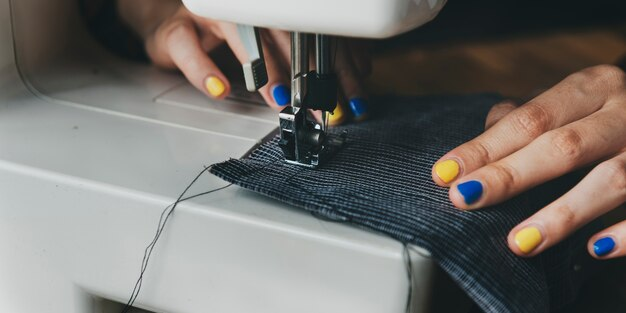
8. Indonesia
Indonesia is turning out to be an increasingly important player in the world clothing manufacturing industry, especially for casual wear, sportswear, and textiles. The country enjoys relatively low labor costs, a growing workforce, and a strategic location in Southeast Asia.
Key strengths of Indonesia’s clothing manufacturing industry:
· Skilled workforce: Indonesia offers a growing labor force skilled in producing textiles and garments.
· Cost-effective production: Indonesia offers competitive labor costs, which appeal to brands looking for affordable production options.
· Diverse production capabilities: Indonesian manufacturers are capable of producing a wide variety of garments, including sportswear, casual wear, and accessories.
9. Pakistan
The textile industry in Pakistan is strong, with a predisposition towards cotton-based garments. It is amongst the largest producers of cotton and has established itself as a key supplier of textiles and garments to international markets.
Key strengths of the clothing manufacturing industry in Pakistan:
· Cotton production: As the fourth-largest cotton producer globally, Pakistan plays an important role in the global textile industry.
· Affordability: Labor costs are low, making it an attractive option for brands looking to cut production costs.
· Specialized textiles: Pakistan excels in producing cotton garments, yarn, and textiles, often for high-volume orders.
10. Mexico
Mexico is an increasingly popular destination for clothing manufacturing, particularly for U.S.-based brands. Its proximity to the United States, combined with affordable labor costs and trade agreements like USMCA, make it an attractive option for nearshoring.
Key strengths of Mexico’s clothing manufacturing industry:
· Proximity to the U.S.: Because of its location, goods can be shipped to U.S. retailers in record time and at a lower cost.
· Trade agreements: USMCA provides manufacturers with trade advantages like low or no tariffs for textiles.
· Competitive pricing: At attractive prices, Mexico can deliver quality goods without compromising on quality, making it a popular destination for fashion brands.
Key Considerations for Choosing the Best Clothing Manufacturing Country for Your Brand
Cost vs. Quality
The selection of a country to manufacture clothing should be balanced between cost and quality. For example, although countries like China and Bangladesh offer low-cost productions, countries like Italy and the U.S. provide high-quality and luxurious fabrics.
Labor Conditions and Ethical Manufacturing Practices
Ensure the country you opt for applies ethical labor practices and maintains a safe working environment. Countries such as Bangladesh and Vietnam are improving their labor conditions, but due diligence must be followed.
Technological Advancements and Innovation in Clothing Manufacturing
Countries such as China and the U.S. are leading in technological advancement and offer value propositions that enhance the industry in terms of quality and efficiency.
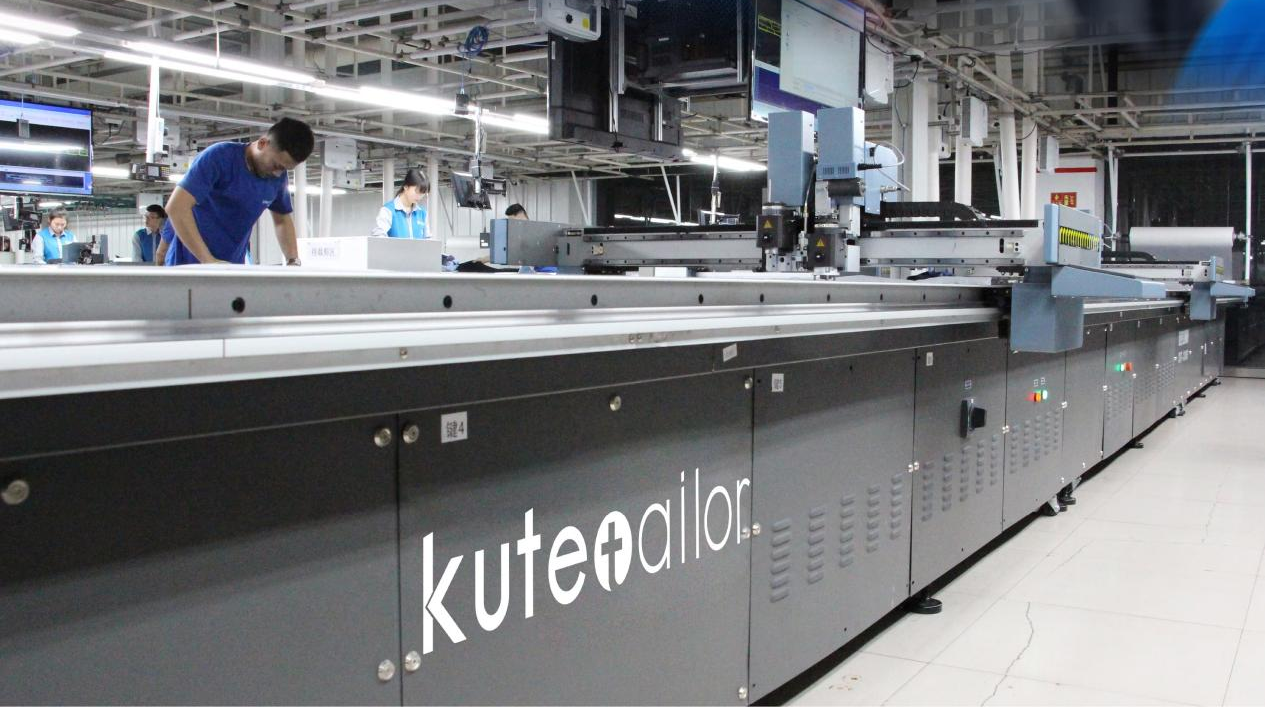
Why China Leads the Global Clothing Manufacturing Industry
Scale and Volume
The unparalleled production scale of China enables it to meet the demand for both large and small clothing brands by offering bulk production and specialized products, making it ideal for custom Smart Casual manufacturing needs.
Advanced Technology Adoption
China is a leader in automation and smart manufacturing, which greatly enhances production efficiency and garment quality.
Cost-Efficiency in Mass Production and Supply Chain Management
With an established supply chain and cost-efficient production capabilities, China can produce high-quality garments at competitive prices.
Extensive Expertise in a Wide Range of Garment Types
China's factories can produce everything from high-end items to fast fashion. This meets a wide array of global brand needs, including made-to-measure suits online and other specialized orders.
Government Support and Export Growth
Support from the government for the textile and garment industries, with export-oriented policies, has helped China maintain its hub position for garment production globally.
In Conclusion
When choosing a country for clothing manufacturing, it’s essential to consider cost, quality, labor conditions, and technological advancements. While many countries offer unique advantages, China stands out as the global leader in clothing manufacturing. With unmatched production scale, advanced technology, cost-efficiency, and extensive expertise across diverse garment types, China provides the ideal solution for brands of all sizes.
As a Chinese clothing manufacturer, we pride ourselves on delivering high-quality products tailored to your brand’s needs. Whether you’re looking for bulk production, custom designs, or niche, high-quality apparel, China’s established supply chain and manufacturing expertise make it the perfect choice. Partner with us, and let’s bring your vision to life with efficiency, reliability, and excellence.
FAQs
1. Which country is best for clothing manufacturing?
China is the best overall for clothing manufacturing due to its scale, cost-efficiency, and diverse production capabilities.
2. Which country makes the highest quality clothing?
Italy is known for producing the highest quality clothing, especially luxury garments, thanks to its craftsmanship and premium materials.
3. What are the top 10 garment-producing countries in the world?
The top 10 are:
1.China
2.Bangladesh
3.Vietnam
4.India
5.Italy
6.Turkey
7.United States
8.Indonesia
9.Pakistan
10.Mexico
4. Can small brands compete with larger companies when choosing a clothing manufacturing partner?
Yes, small brands can compete by finding manufacturers that offer flexible terms of collaboration, such as those in Vietnam and Mexico. China is also a possibility.
5. Which country is the best for fast fashion production?
Bangladesh and China are the best countries for fast fashion because the labor costs are low there, while the pace of production is fast.
MORE 2024-12-10 -
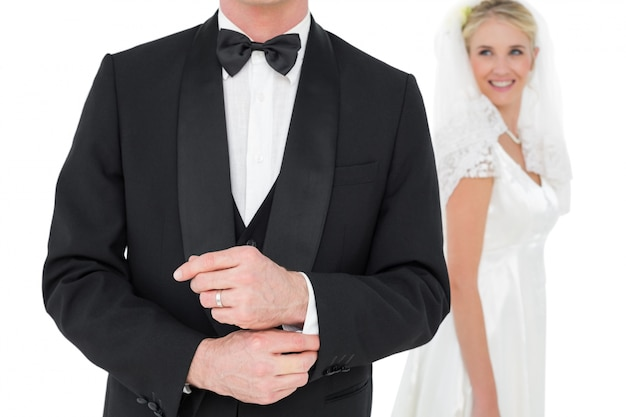 A Groom’s Guide to Wedding Tuxedos: Everything You Need to Know
A Groom’s Guide to Wedding Tuxedos: Everything You Need to KnowYour wedding day is one of the most special days of your life, and the tuxedo you wear can really set the tone for the entire celebration. While many grooms opt for traditional suits, the wedding tuxedo offers a distinct, elevated look that is designed to make you stand out. But what exactly is the difference between wedding tuxedos and regular suits, and how would you know when to choose one over the other? This guide will walk you through everything you need to know about wedding tuxedos, from understanding the key features to the benefits of custom fits, and more.
What Makes Wedding Tuxedos Different from Regular Suits?
Among the first decisions that one will have to make when preparing for a wedding is to choose between a tuxedo and a suit. While both of these are formal attires, there are a number of differences that distinguish a wedding tuxedo from any other regular suit.
Key Features of a Wedding Tuxedo
Wedding tuxedos are always more formal than suits and come with some distinct features. These include:
· Shiny satin lapels: The most distinctive marking of a tuxedo is the lapels made of satin or silk that are in contrast to the rest of the jacket. This gives it a really shiny finish and makes the tuxedo really formal.
· No pleats in the trousers: Most tuxedos do not have pleats in the trousers. Instead, these are smooth and clean in fit.
· Studs on the shirt: Instead of using the general buttons, tuxedo shirts use small studs for elegance.
· A bow tie: While ties are acceptable for suits, tuxedos are traditionally worn with a bow tie to elevate the formal style.
These design elements give a tuxedo a timeless, formal elegance that a regular suit just can’t match.
When to Choose a Tuxedo Over a Suit
While both tuxedos and suits can be worn at a wedding, choosing the right one depends on the formality of your event. A tuxedo is usually worn to evening weddings or formal events, while suits are better for daytime, semi-formal, or more casual weddings.
If you're wondering, "Can you wear a tuxedo to a wedding?" the answer is simply yes; however, this is best for very formal or black-tie weddings. If your wedding has a more relaxed or semi-formal vibe, a suit may be a better fit.

Can You Wear a Tuxedo to a Wedding?
The question many grooms ask is, "Can you wear a tuxedo to a wedding?" The answer largely depends on the nature of the event and the dress code. Commonly, tuxedos are associated with formal or black-tie weddings, though they can work at other types of events with the right styling.
Types of Weddings That Call for a Tuxedo
A tuxedo is appropriate for weddings where formality is key. These include:
· Black-tie weddings: The most formal wedding dress code, where tuxedos are expected.
· Evening weddings: A tuxedo is often the preferred choice for weddings that take place after 6 p.m.
· Luxury or destination weddings: If your wedding is being held in a luxury venue or as part of a high-end celebration, a tuxedo will elevate the look.
Understanding Wedding Dress Codes
Understanding the dress code of your wedding is vital to make the decision between a tuxedo and a suit. The following are some common wedding dress codes:
· Black tie: A tuxedo, bow tie, and patent leather shoes are worn.
· Semi-formal: A suit may be acceptable, though a tuxedo will work.
· Casual: A suit or even a dress shirt with trousers is appropriate.
Being sure of the dress code helps you decide whether a tuxedo or a suit would be best for your wedding.
The Benefits of Custom Wedding Tuxedos
While you can rent or buy a pre-made tuxedo, custom wedding tuxedos offer several advantages that can enhance your look on the big day. Working with a custom apparel manufacturer ensures that the tuxedo is made to fit your exact measurements and personal style, making it a standout choice for your wedding.
Why Custom Fits Matter for Your Wedding Day
A custom wedding tuxedo is tailored specifically to your measurements, ensuring that it fits perfectly and highlights your best features. When you invest in a custom tuxedo, you get:
· A perfect fit: By ordering a custom tailored tux, you will need no alterations. From the shoulders all the way to the hem, it will fit your body as it should.
· Comfort: Being that a custom tuxedo is fitted to your unique body type, you will stay comfortable throughout the day with ease.
· Confidence: A tuxedo that fits like a glove will boost your confidence, allowing you to enjoy your wedding day without having to give much thought to what you're wearing.
Fabric and Design Options for Custom Tuxedos
One of the biggest benefits of going for a custom tuxedo is the diverse range of fabrics and design options. You can choose:
· Fabric: From luxurious wool to velvet and satin, the fabric you choose can add a unique touch to your tuxedo.
· Lapels: Choose between shawl lapels, peak lapels, or notch lapels to match your personal style.
· Buttons and stitching: Add a personalized touch with custom buttons or embroidery.
The possibilities are endless, making a custom tuxedo a unique representation of your style on your wedding day.
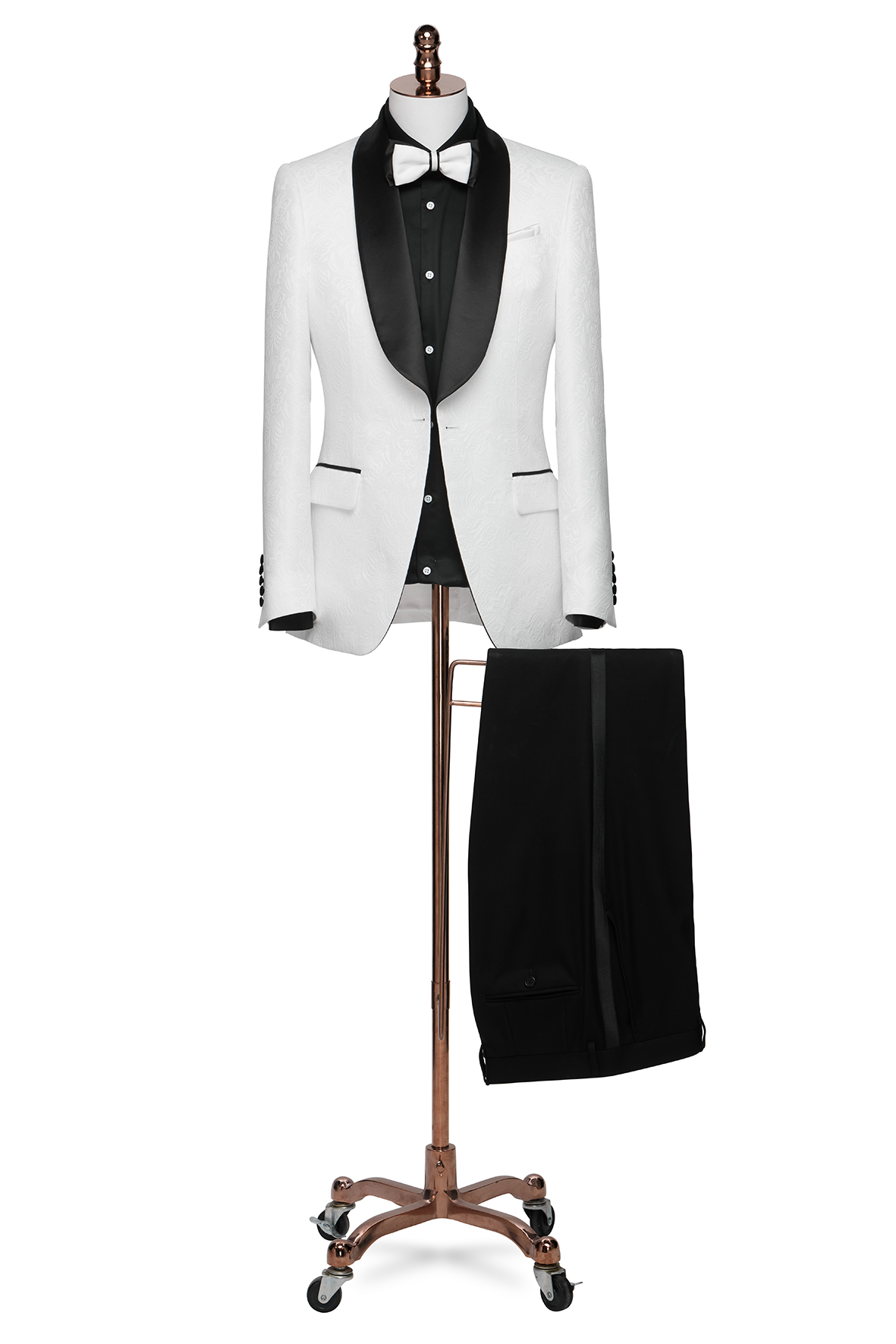
When and How to Wear a Tuxedo to Your Wedding
Once you’ve chosen your wedding tuxedo, it’s important to know when and how to wear it for maximum impact.
Matching the Tuxedo with Your Wedding Theme
The tuxedo must complement your wedding's general theme. If it is going to be a traditional, black-tie wedding, then one could opt for a classical black tuxedo. In modern or themed weddings, grooms can select other colors such as navy and burgundy. You may also try velvet for a rich, plush look.
If you're looking for custom Smart Casual options for a less formal wedding, a more relaxed take on tuxedo styles with a modern twist could be the perfect choice.
Key Tuxedo Styling Tips for Grooms
Keep these tuxedo styling tips in mind to make sure you look your best on the big day:
· Keep it simple: Avoid over-accessorizing. You just need a classic bow tie and some cufflinks.
· Choose the right shoes: Patent leather or polished black shoes to go along with the formality of the tuxedo.
· Fit matters most: The tuxedo needs to fit well—be it tailor-made or altered to perfection.
The right styling of a tuxedo will make you look dashing and surely feel confident as you walk down the aisle.
FAQs
1. Can you wear a tuxedo to a wedding without a bow tie?
While a bow tie is traditional, it's not required. You can opt for a tie or even a cravat for something a bit more personal, but a bow tie remains the most classic choice.
2. What is the difference between a tuxedo and a suit for a wedding?
The major difference is in the details of the design: tuxedos have satin lapels, a formal shirt with studs, and are usually worn with a bow tie, whereas suits have regular lapels and can be worn with a tie.
3. How far in advance should I order my custom tuxedo?
It's highly recommended that you order your custom tuxedo 2-3 months in advance to give ample time for fitting and adjustments.
4. What accessories should I wear with my wedding tuxedo?
A classic bow tie, cufflinks, a pocket square, and polished black shoes are necessary. Adding a watch or a lapel pin can be used for personal touches.
5. Should I rent or custom my wedding tuxedo?
Renting is a more budget-friendly option, but custom formal wear provide a perfect fit and lasting quality. If you want to keep your tuxedo after the wedding or have a specific vision, opting for a custom tuxedo is worth the investment.
MORE 2024-12-07 -
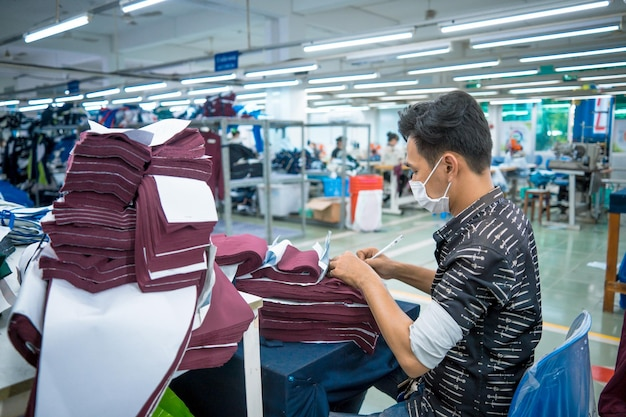 China Clothing Manufacturers vs. American Clothing Manufacturers: Which Is Better?
China Clothing Manufacturers vs. American Clothing Manufacturers: Which Is Better?When it comes to sourcing clothing for your brand, one of the biggest decisions is selecting the right manufacturer. In terms of clothing production, the two major options are China and the United States. Each has its own advantages and challenges. In the article below, we will discuss the strengths and weaknesses of China clothing manufacturers versus American clothing manufacturers, based on key factors such as cost, quality, and methods of production. By the end, you will have a better idea of which one will suit your business needs.
Overview of China Clothing Manufacturers
China has conventionally been regarded as the leading country in the world for the production of textiles and garments. Large-scale production capacity and efficiency make it a hub for textile companies around the world, and many custom clothing manufacturers in China offer competitive pricing for brands looking for bulk production.
Historical Context of Chinese Clothing Manufacturing
The manufacturing boom for China started in the late 20th century when economic reforms opened up the doors to international trade and investment. Its labor force was growing at a rapid rate, offering cheap skilled labor, which allowed the scaling up of manufacturers. Over time, China has earned a reputation for producing large volumes of clothing at competitive prices.
Key Production Methods in China
The production methods of China are based on mass manufacturing and automation. Most Chinese manufacturers depend on large-scale factories with advanced machinery, which enable them to produce clothes in bulk within a short period. However, many manufacturers also cater to niche markets, including custom men's casual wear and other specialty garments. In recent years, many companies have also specialized in selling high-end custom formal wear and made-to-measure suits online.
The country is specifically known for the production of fast fashion and low-cost garments. However, China has also been developing to produce higher-quality products, including premium fabrics, luxury brands, and eco-friendly materials.
Cost Efficiency of China Clothing Manufacturers
One of the most attractive reasons to work with China clothing manufacturers is their cost efficiency. Labor costs in China are generally lower than in many Western countries, making it cheaper to produce clothing. In addition, China benefits from economies of scale due to its massive production capacity, reducing the overall cost per unit.
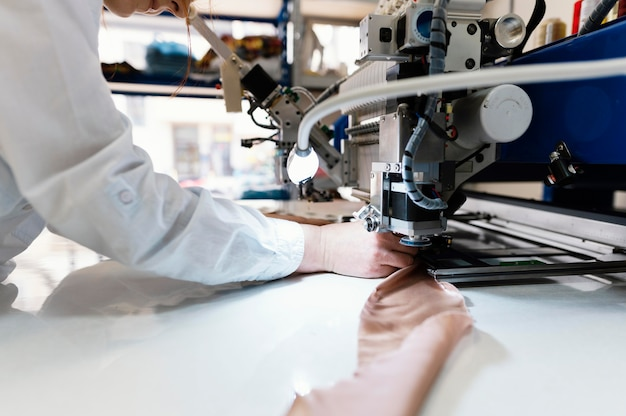
Overview of American Clothing Manufacturers
The United States has a long history of clothing production, but in recent decades, the industry has experienced a decline in domestic manufacturing. However, there is a resurgence of "Made in America" apparel, driven by rising demand for locally produced goods and more sustainable practices.
Historical Development of American Clothing Manufacturing
The U.S. used to be a global powerhouse in clothing production, especially during the early and mid-20th century. However, with the advent of cheaper labor in countries like China and Bangladesh, many American manufacturers moved their production overseas. In recent years, though, there has been a shift back to local manufacturing, especially among high-end and sustainable brands.
Production Methods in the U.S.
American manufacturers generally use a mix of traditional and modern production methods. Though mass production is done, there is more emphasis on small-scale manufacturing and craftsmanship. Consequently, many U.S. clothing manufacturers specialize in quality garments, niche markets, or made-to-order products.
The U.S. is also first in embracing environmentally friendly production techniques and sustainable materials, thus appealing to a growing number of customers who pay close attention to ethical means of production.
The Cost of Producing Clothing in the U.S.
Manufacturing in the U.S. tends to be a lot more expensive than manufacturing in China. The main reason for this is due to higher wages among American workers, along with higher labor laws and environmental regulations. This can be offset, though, as the "Made in America" appeal can provide higher premiums in certain markets.
Comparison: China vs. America Clothing Manufacturers
Now that we’ve looked at the basics of clothing manufacturing in both China and the U.S., let’s dive deeper into a head-to-head comparison of China clothing manufacturers vs. American clothing manufacturers.
Production Efficiency: China vs. America
Factory productivity and efficiency are a common subject, as China benefits from several large-scale factories, an immense use of automation, and extensive manpower. Since China does big batches, their efficiency in producing clothing cannot be that easily matched.
Contrasting this, American manufacturers in the clothing industry focus more on quality than quantity. Hence, these may not be able to rival the speed of Chinese producers, but American manufacturers do great work on high-end, tailored, and low-volume production, so if you're after craftsmanship, look to the U.S.
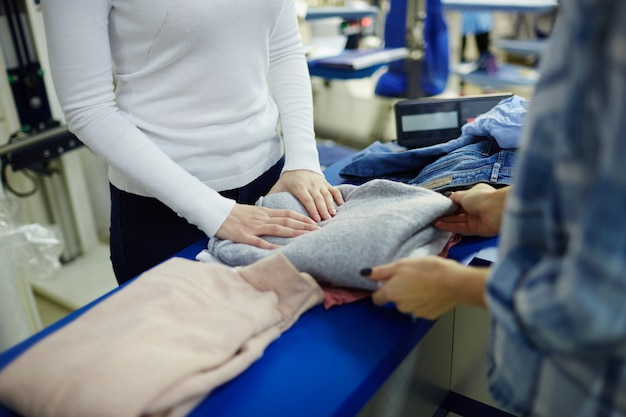
Quality of Clothing: China vs. America
Speaking qualitatively, China's clothing manufacturers have attained a leap in this dimension. Though they have traditionally been considered low-cost, bulk clothing producers, today Chinese manufacturers will produce everything, from a range of high-quality to high-end and eco-friendly apparel.
On the other hand, American manufacturers have made a name for themselves in the production of quality products, especially niche markets. Many clothing manufacturers in the U.S. have specialized in premium materials combined with attention to detail, thus making them an ideal choice for high-end, tailored garments.
Cost Comparison: Why China is Better
When it comes to comparing costs, China takes the lead. With lower labor costs and lax environmental regulations, plus the economies of scale involved, Chinese production rates come out much cheaper than those of the U.S. Hence, China is the ultimate destination for brands that produce high volumes of apparel at low costs. But this cost-saving involves some trade-offs, especially with labor practices and environmental concerns.
In comparison, American manufacturers tend to be pricier due to a higher cost of labor and firmer regulations. However, a "Made in USA" brand can add value to the brand, allowing them to enjoy premium prices for domestically produced goods.
Key Factors to Consider When Choosing Between Chinese and American Manufacturers
When deciding between China clothing manufacturers and American clothing manufacturers, there are several key factors to consider. Each option offers distinct advantages depending on your brand’s specific needs.
Choosing Based on Your Brand's Needs
If your brand is new, offering affordable clothing with a focus on big volumes, then China will probably be a better choice. Chinese factories are ideal for fast and inexpensive production; hence, Chinese manufacturers could be the best option if you are planning to manufacture a fast fashion brand or quickly scale your brand.
If your brand, however, focuses on quality, sustainability, or local production, American manufacturers may be a better fit. Many U.S. clothing manufacturers specialize in high-quality garments and are a great choice for premium, custom, or small-batch productions.
How to Navigate Cost and Quality Trade-offs
While cost and quality are indeed competing factors, a balance can be reached. With the right selection of suppliers, you can find manufacturers in both China and the U.S. that can offer you the best combination of cost and quality with production speed. Remember that some manufacturers will have some flexibility in pricing, especially if you negotiate the volume and complexity of your order.
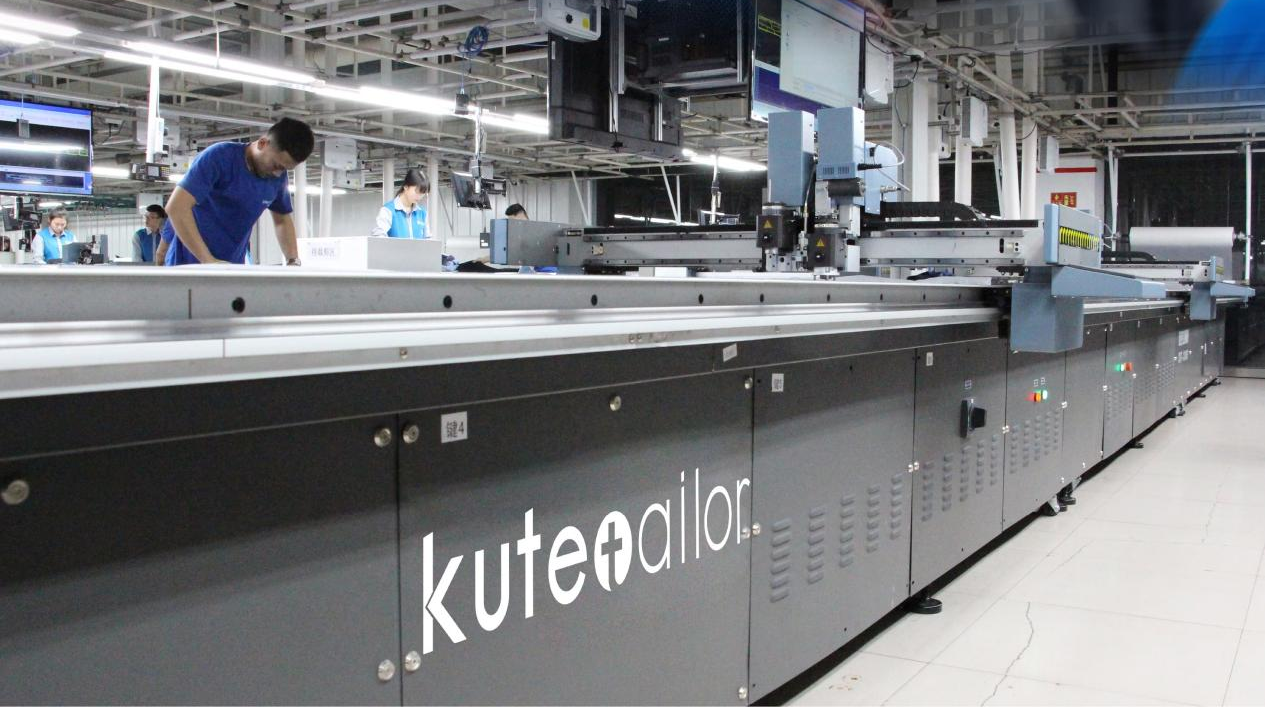
Conclusion: Which is Better for Your Clothing Business?
In the end, it all depends on a number of factors regarding your brand's budget, quality expectations, and production needs as to whether China clothing manufacturers or American clothing manufacturers are better.
· China is ideal for businesses that prioritize cost efficiency, mass production, and quick turnaround times.
· The U.S. is better suited for brands that focus on quality, sustainability, and smaller production runs.
By understanding the strengths and weaknesses of each option, you can make an informed decision that aligns with your brand’s goals and values.
FAQs
1. Which is better: China or American clothing manufacturers for high-quality apparel?
American manufacturers are generally known for higher-quality production, especially in niche and premium markets. However, China has also made significant improvements in producing high-quality clothing, especially for luxury brands.
2. What are the main differences between Chinese and American clothing manufacturers in terms of cost?
The main difference is in cost efficiency. China offers much lower production costs because of cheaper labor and more scalable manufacturing practices, while U.S. manufacturers have to deal with higher labor costs and stricter regulations that raise production costs.
3. Can I find good quality clothing manufacturers in both China and the U.S.?
Yes, both countries offer high-quality clothing manufacturers. China has a wider range of options for budget-conscious buyers, while American manufacturers are known for premium, small-batch clothing and craftsmanship.
4. How can I avoid common pitfalls when working with Chinese or American clothing manufacturers?
To avoid pitfalls, it’s crucial to thoroughly vet manufacturers, communicate clearly about your quality standards and delivery timelines, and always request samples before placing large orders.
5. What are the most common production methods used by Chinese clothing manufacturers?
Common production methods include mass manufacturing using automation, as well as more recent trends in eco-friendly and sustainable manufacturing processes.
MORE 2024-12-04 -
 Bow Ties with Suits: A Modern Gentleman's Guide
Bow Ties with Suits: A Modern Gentleman's GuideBow ties have transcended their traditional roots to become a versatile accessory for modern style. Whether you're dressing for a wedding, business meeting, or casual event, pairing a bow tie with a suit can elevate your look. This timeless accessory, once reserved for formal occasions, has made a comeback in contemporary fashion, offering a stylish alternative to the classic necktie. This guide explores bow tie styles, matching options with suits, and innovative ways to wear them.
Can You Wear a Bow Tie with a Suit?
Yes, you can—and should—wear a bow tie with a suit! Bow ties add a certain je ne sais quoi to your outfit, separating you from the sea of neckties. However, choosing the right bow tie depends on the occasion:
Formal Events: Wear a bow tie with a three-piece or double-breasted suit for a polished look.
Business Settings: Stick to subtle designs and darker tones to keep it professional.
Casual Gatherings: Experiment with playful patterns or unconventional fabrics to showcase your personality.
The key lies in balancing the bow tie’s style and color with your suit and shirt. A well-chosen bow tie adds flair and refinement, but overdoing it can detract from the overall aesthetic.
Understanding Bow Tie Styles
Choosing the right type of bow tie is essential for nailing the perfect look. Here are the three main styles:
Self-Tie Bow Tie
This is also referred to as a "freestyle" bow tie because it is supposed to be tied by the wearer. You have full control over the shape and the way it sits. Mastering the art of tying your own bow tie gives you a sense of accomplishment and adds an authentic, personal touch to your outfit.
Best For: Custom formal wear events and traditionalists who appreciate artisan craftsmanship.
Pro Tip: A self-tie adds an air of authenticity and class.
Pre-Tied Bow Tie
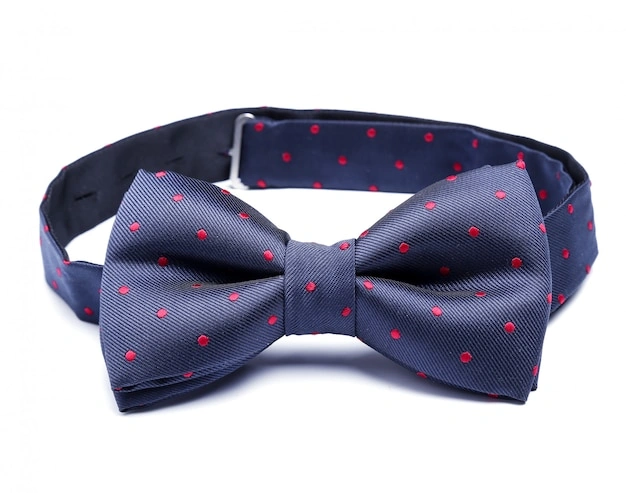
Pre-tied bow ties come with an adjustable strap for convenience and consistent shapes. Perfect for those who are looking for ease and simplicity without compromising style.
Best For: Beginners or custom smart casual events where ease and quick adjustments are preferred.
Pro Tip: Ensure the material of the pre-tied bow tie is in sync with the texture of your suit for an integrated look. A pre-tied bow tie should complement your overall outfit, rather than detract from it.
Clip-On Bow Tie
The most basic, clip-on bow ties attach directly to the collar. While they are the quickest and easiest option, clip-ons are often seen as less refined than self-tie or pre-tied options.
Best For: Children or informal situations.
Pro Tip: Use clip-ons sparingly; self-tie or pre-tied options are generally more polished.
Matching Bow Ties with Various Suit Styles
The combination of a bow tie with your suit is determined by the cut and style of the suit. Here's how to make the best combinations:
Single-Breasted Suits
A single-breasted suit works well with bow ties for both formal and casual occasions. For fitted suits, choose slim bow ties so that your line of view remains sleek.
Double-Breasted Suits
The double-breasted suit is quite formal, so classic black or dark-colored bow ties are suitable for them. A well-tailored double-breasted suit with a bow tie exudes confidence and refinement, making it ideal for upscale events. Peak lapels on double-breasted suits go particularly well with larger bow ties.
Three-Piece Suits
The three-piece suit is perfect for weddings or galas where a bow tie adds charm. Play with textures such as velvet or silk for a luxurious feel. For added flair, you can mix and match textures, like pairing a velvet bow tie with a wool suit.
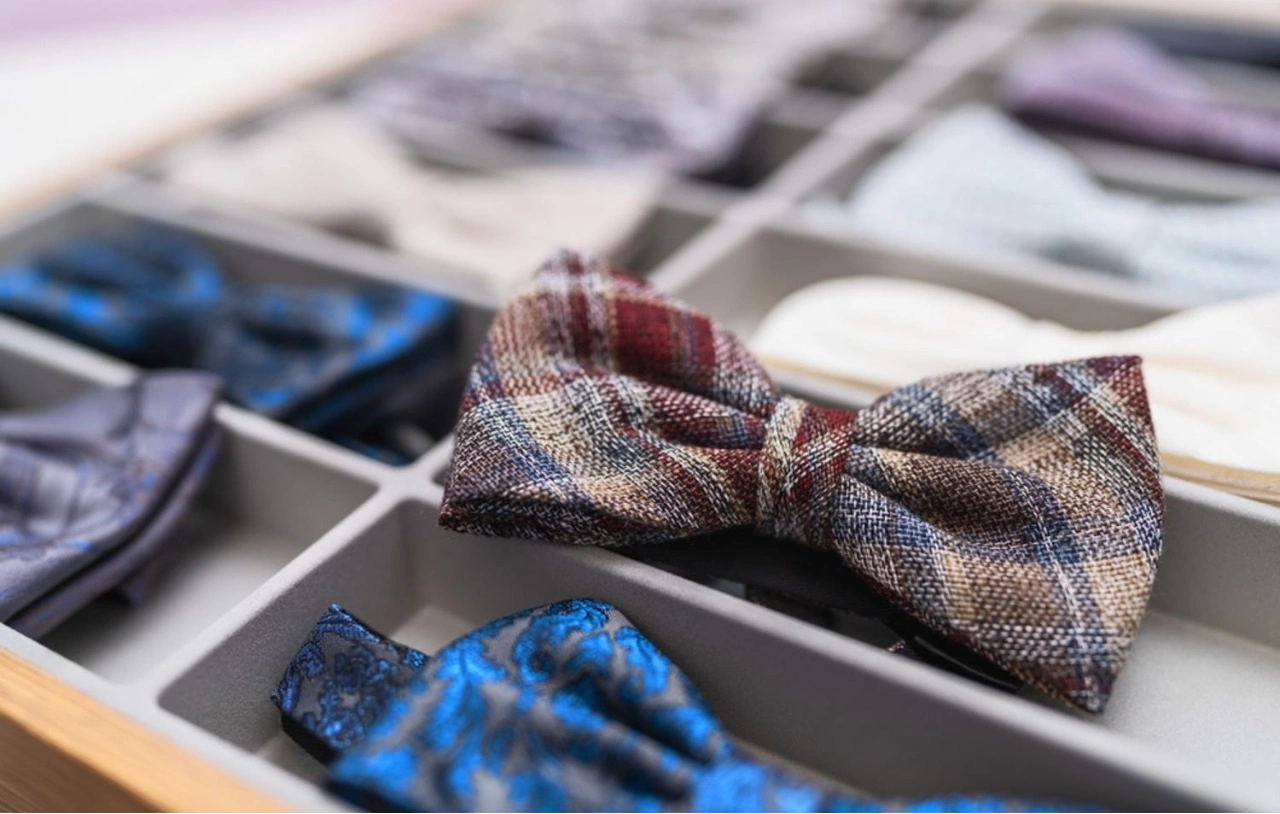
Bow Tie Color and Pattern Selection
The color and pattern of your bow tie can make all the difference in the overall feel of your suit.
Solid Colors
Formal Events: Black, navy, or burgundy are classic choices.
Business Settings: Stick to muted tones like charcoal or grey.
Casual Events: Bright shades, such as mustard or teal, can make a statement.
Patterns
Polka Dots and Stripes: Add a playful touch without overwhelming your look.
Paisley or Florals: Ideal for creative or casual settings, especially in spring or summer.
Seasonal Trends
Opt for heavier fabrics like wool in winter and lighter materials like cotton in summer. Seasonal colors—pastels for spring and jewel tones for fall—can help align your outfit with the time of year. A pastel bow tie is a great choice for spring weddings, while deep, rich tones work wonderfully for fall gatherings.
Creative Ways to Wear Bow Ties Now
Bow ties are no longer limited to traditional suits. Here are some modern ways:
Layering with Vests
Add a vest under your suit jacket and pair it with a bow tie for a distinguished layered look. Layering adds depth to your outfit and introduces an element of vintage charm that is making a comeback in modern fashion. This style is ideal for weddings or vintage-themed events.
Sustainable and Personalized Bow Ties
Look at options made of recycled or organic materials. Sustainable fashion is becoming more popular, and opting for eco-friendly bow ties shows your commitment to style and the environment. Add an element of personalization with customized embroidery or monograms that make it truly yours.
Modern Bow Tie Alternatives
Knitted Bow Ties: Very casual, great for that textured look.
Wooden Bow Ties: Whimsical but very stylish to wear outdoors or in themed parties.
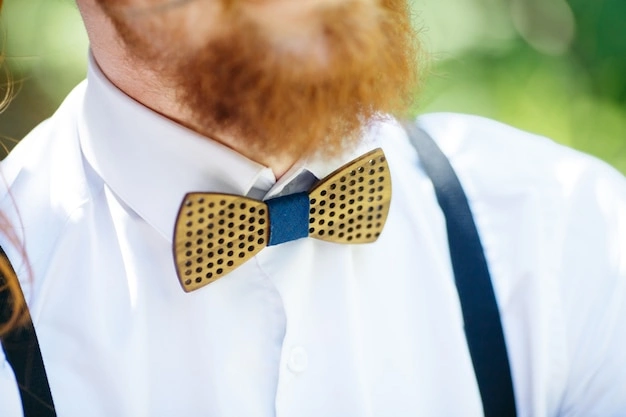
For those looking to create custom bow ties that align perfectly with their style and needs, it's important to consider working with custom apparel manufacturers who specialize in creating tailored clothing and accessories. They can help you design a bow tie that complements your suit and reflects your unique taste.
FAQs
1. Can you wear a bow tie with a suit at a wedding?
Absolutely! Weddings are one of the best occasions for a bow tie. Match the color of the bow tie to the wedding theme or your partner's attire for a coordinated look.
2. Is a bow tie suitable for business meetings?
Yes, but use simple designs and darker colors to maintain professionalism.
3. What are the differences between self-tie and pre-tied bow ties?
Self-tie bow ties provide a more genuine and personal look, whereas pre-tied options save time and ensure an accurately shaped bow every time.
4. Which shirt collars work best with bow ties?
Wear a spread or wingtip collar shirt for displaying the bow tie in good style.
5. How can I match bow tie patterns with suit designs?
Stick to complementary colors, avoid clashing patterns. For example, a polka dot bow tie works well with a solid suit.
MORE 2024-11-30

